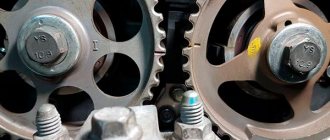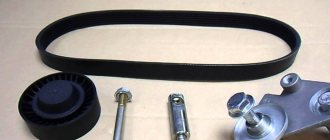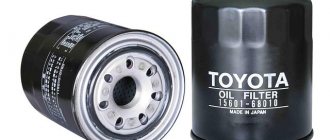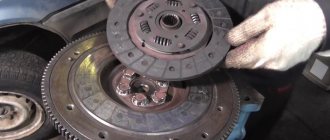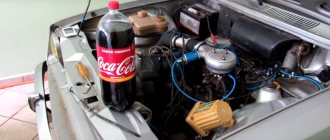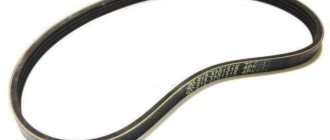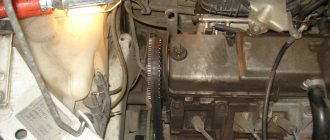Timing belt modifications
Since the invention of the car, developers have offered different types of timing belts. At different times, mechanism belts were made from different materials and in different variations:
- leather product;
- metal chain;
- a metalized modification with a rubber base, which is used today on cars of all types and from various manufacturers.
Timing belt
The indisputable advantages of modern timing belts include:
- Ease of use.
- Reliability of the design.
- Acceptable price.
A metal chain is highly expensive and complex in design, and therefore this type of belt is practically not used in budget cars. Leather samples have a short service life and, despite their minimal cost, are not popular among modern motorists.
Consequences and causes of timing belt breakage
How serious the consequences of a broken timing belt will be for your car is directly related to the design of the engine; the simpler it is, the less likely it is to damage it.
Most often they can entail:
- Engine overhaul.
- Restoration of the gas distribution mechanism.
- Bent valves – Occurs when the timing belt breaks as they are lowered to release gases or inject fuel. In this case, the crankshaft continues to rotate by inertia and is met by the pistons, which in turn can cause a strong blow to the valves. However, this problem is typical only for cars with a specially reduced combustion chamber or in the absence of sampling on the pistons. To determine the extent of damage, it would be best to transport the car to a service station, since it will be necessary to dismantle the cylinder head and diagnose the engine using special equipment. It would be best to replace the entire set of valves, even if at the time of the break, the engine was idling and only 3-4 of them were damaged.
- Piston failure - Most often occurs on Japanese cars and occurs from a strong impact with the valve heads. If the belt breaks at high speed and all the valves are bent, the bushings will burst and the pistons will be punctured by fragments. In this case, very expensive repairs will be required, including replacing the head.
The most serious consequences of a broken timing belt are observed in diesel engines, the design of which practically does not allow the valves to move, so if they break, when they are in the top dead center position, they can simultaneously become unusable:
- Camshaft with bearings
- Cylinder head
- Connecting rods are deformed
- Valve bends
Why does the belt break?
The main reason why a belt breaks is due to the careless attitude of the car owner. It's all about untimely replacement of a worn part. The average belt replacement interval is sixty thousand kilometers. The first time drivers change a part at a service station, and then they simply forget about this event.
There are a number of main reasons why a belt may break:
Quality of spare parts
The quality of spare parts depends on the brand of timing belt manufacturer. You should not skimp on such details. For the middle price segment, belts from the following brands have become very popular: Balakovo, Bosch, Lemforder. More expensive - Gates, Contitech, Dayco. To avoid any troubles during operation of the part, carefully select parts. The roller jams or releases spontaneously.
Incorrect belt installation
Quite often, a break occurs after 1000-2000 km. after the previous replacement. The main reason is insufficient or excessive tightening. It is best to carry out such work from trusted professionals, and also check the condition of the car after the work. Listen to see if the sound the engine makes has changed. Check to see if the belt has slipped or cracked.
Broken tension rollers
Tension rollers are designed to tension the timing belt. They prevent parts from jumping off and slipping. A roller is a kind of bearing with a special coating. All parts have their own service life. A worn roller is noisy and if you do not replace it, it will ruin the timing belt in a short period of time.
Pump wedge
Most often, cars from Russian manufacturers are susceptible to such breakdowns. This is a rare occurrence in foreign cars. If the pump jams, the belt breaks and requires replacement.
Late replacement
Aging and wear of the part is one of the most common causes of rupture. According to average indicators, belt breakage occurs after sixty thousand kilometers. In foreign-made cars, this figure can reach one hundred and fifty thousand kilometers. But everything has its limit. During use, the part wears out and becomes unusable. Belt wear is the most common cause of component damage. In Russian cars, the service life of the belt may be even lower than described above, so when buying a used car, it is better to immediately replace the timing belt.
Foreign elements
Sometimes oil and dirt can get on the part and jam the distributor or crankshaft. Be sure to check the protective cover and fasteners. If necessary, replace.
Please note that if the car operates in difficult conditions (frequent short trips, cold seasons, insufficient engine warming up), then the timing of replacing the timing belt is reduced.
Belt Drive Features
The timing belt is immune to resonant vibrations because it has an odd number of teeth (it is not a multiple of the number of teeth on the gears). The belt drive operates almost silently (unlike a chain drive), and its elasticity allows it to cope with torsional vibrations. The belt is insensitive to pressure in the lubrication system, as well as to the quality of the engine oil.
However, it has a number of features due to which the part requires regular inspection and timely replacement. These include:
- dependence on the condition of the pump, as well as tension and guide rollers;
- vulnerability to low temperatures;
- incompatibility with petroleum products (they chemically destroy the belt material).
The timing belt does not show signs of critical wear or damage; they can only be detected by visual inspection. This means that if it is excessively worn or seriously defective, it will break without warning: this is its main difference from most other automotive parts, which initially squeak, knock, vibrate, hum, or otherwise let you know that there is a problem.
Important! Regularly check the timing belt for visible defects or wear - this is the only way to determine the need for emergency replacement.
About the timing belt
The timing belt synchronizes the operation of the crankshaft with the camshaft, and, more simply, it participates in converting energy from fuel combustion inside the engine into motion energy transmitted through the transmission to the wheels. Belts can be rubber, in the form of a solid ring, or metal, in the form of a chain. The second option is considered more durable, but nothing lasts forever and the chain also stretches. It costs more, but it has to be changed less often. The procedure for replacing a belt depends on the car, but as always, it is better to change a part that is still working than to eliminate the consequences of a breakdown. In this article we are talking about a rubber product.
Nature of timing belt breakage
No less influential on the consequences that a broken timing belt entails is its nature, because in some cases it does not break; instead, one or more teeth are cut off on it. In this case, both the crankshaft and the camshaft continue to rotate, striking all nearby parts with the pistons.
Similar damage can occur even if the belt teeth remain intact but jump over the teeth of the timing sprocket.
How does timing belt work?
Let's consider this mechanism in more detail. The upper part of the cylinder of a modern engine is cramped: there are two or four valves, a spark plug, and a fuel injection nozzle. And the head arch is made low and almost straight to achieve a high degree of compression and increase power.
When the timing camshaft unwinds, thanks to special cams with a complex profile, it presses on the valve stem and opens it to release exhaust gases. The camshaft and crankshaft must be synchronized. If the piston goes down, the valves let in the mixture, and when the piston moves up, they close. This creates pressure in the combustion chamber. Next, the candles ignite the mixture, which pushes the piston. This cycle is repeated many times.
Much more often, when the timing belt breaks, the valve only bends and stops closing completely, causing the engine to operate unstably and with an unusual ringing sound.
Therefore, it is better not to let the timing belt break, carefully study its condition and install a new one on time, as required by the maintenance regulations.
Possible costs and belt replacement procedure
The cost of one valve, excluding additional costs, averages a thousand rubles, and considering that all 16 may need to be replaced, you can imagine approximately how much the repair will cost.
In addition to the accompanying little things, you will need to purchase:
- A new belt, or a timing belt kit with a tensioner and idler pulley.
- Gaskets for intake and exhaust manifolds.
- Cylinder head gaskets and valve covers.
- Set of mounting bolts.
- Possibly the water pump (Pump), if wear is suspected.
The easiest way to perform the replacement operation is on a lift. To work you will need:
- a set of keys
- screwdriver
- locating pins for timing marks
- in some cases special tool.
To remove the old belt, follow the following action plan:
- Remove the timing case - secured with several bolts.
- Unscrew the crankcase protection bolts.
- Next, remove the compressor belt. To do this, dismantle it, remove the belt and install the compressor in place.
- Remove the alternator belt.
- To disconnect all contacts, remove the terminal from the battery.
- Unscrew the mounting bolts from the engine and remove the generator, terminal and pump pulley, remembering to first remove the bolts holding them.
- It may be necessary to remove the engine mount.
- Remove the protective cover from the timing belt
Now proceed with the actual replacement, for which you will need to remove the timing pulley covers and pull out the old timing belt. Put a new one in its place and tighten the tensioner. If the rollers become unusable, they should also be replaced. Next, assemble the structure in reverse order. Keep in mind that each car brand has its own characteristics of removing and installing the timing belt, however, in general they are very similar.
Procedure for replacing the timing belt
To remove the old timing belt, you must perform the following steps:
- Remove the timing case, which is secured with several bolts.
- Unscrew the fasteners on the crankcase protection.
- Remove the belt from the compressor by dismantling it, remove the belt and return the compressor to its proper place.
- Remove the belt from the generator.
- To de-energize the contacts, you must remove the terminal from the battery.
- Unscrew the fasteners on the engine and remove the generator, terminal and water pump pulley, remembering to first remove the corresponding bolts.
- It is possible that it will be necessary to dismantle the base of the power unit.
- Remove the protection cover from the timing belt.
How to determine a break and what not to do
For an inexperienced motorist, identifying a break is not so easy. Your car will simply stall and will not start.
To begin with, I will say this - if the timing belt breaks, the car will not start under any pretext, because the compression is broken. Beginners often “turn” the engine until the battery is seated, but it does not start - this is not correct! You are only aggravating the situation - the piston, like an “anvil,” hits the already bent valve, and you add more. Should not be doing that!
The second sign is that the engine rotates too easily, if you can identify it, it feels like no one is holding the pistons - of course there is no compression!
Well, and probably the last thing - open the hood and look at the timing system, if possible, sometimes it is closed, if you see pieces of the belt - urgently go to the service station. We call a tow truck.
In conclusion, I would like to add that the entire timing system needs to be changed, and this includes the belt, rollers, and tensioners - a complete set. Then the operation will be stable and safe - your engine will last for many years.
Now a short but useful video.
I hope you liked the article, read our AUTOBLOG, it will be interesting.
( 45 votes, average: 4.51 out of 5)
What happens when there is a break?
The consequences of a broken timing belt depend entirely on the design of the power unit. To imagine what will happen at this moment, you need to turn to the mechanics of the internal combustion engine.
In a running engine, the pistons continuously move from one dead center to another. During the intake stroke, the piston moves down and the intake valve opens; during the exhaust stroke, the exhaust valve opens and the piston moves up. At the moment when the piston is at top dead center, all valves must be closed.
If the timing belt breaks, the camshaft stops rotating and the valves stop in one position. At the same time, the crankshaft continues to rotate by inertia, and the pistons rush towards the open valves.
In some engines, for example, the 8-valve VAZ-2111, the pistons have special recesses to avoid contact with the valves in the event of a break. In this case, there will be no consequences, except that the car will not be able to get to the garage or workshop under its own power.
Modern multi-valve engines are designed to get maximum power from a small volume, so the pistons do not have such recesses, or they are not deep enough. For such engines, a broken timing belt means an inevitable meeting of the pistons and valves, causing the latter to bend.
If the belt breaks at idle, as a rule, only a few valves are bent; if the car was moving in gear and the speed was high, most likely the entire set will need to be replaced.
Car service technicians, as a rule, rightly advise changing the entire set of valves in any case.
The higher the crankshaft speed at the moment of the break, the more severe the consequences. In addition to bent valves, their guide bushings may burst, which in turn threatens the repair or replacement of the cylinder head or the block itself. In addition, the impact may destroy the pistons.
There are even cases where a break occurred at high speed, and all the valves were bent due to the impact, the head of the block received damage that was “incompatible with life,” the guide bushings burst, and their fragments pierced the pistons through and through. Repairing such motors is extremely expensive. According to statistics, double-shaft (DOHC) engines of Japanese manufacturers most often suffer such damage.
However, in comparison with diesel engines, the consequences of a broken timing belt for gasoline engines are quite mild. Due to the specific design, the valves have almost no free play when the piston is at TDC. As a result of the break, the destruction takes on the character of a domino:
If a break occurs at high speeds, the pistons can also be destroyed and the cylinder block damaged.
